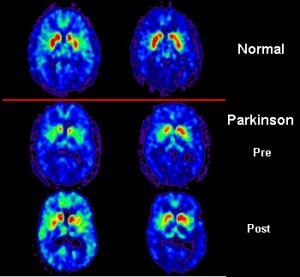A Novel Approach To Parkinson’s Disease Treatment
Introduction
My capstone project focused on a Parkinson’s disease (PD), and in particular, a relatively new intervention program for this diagnosis. I have always had a particular interest in this patient population and during my clinical rotation last year in geriatrics, I was given the opportunity to help work with many fantastic patients with PD. This experience motivated me to learn more about the specific pathophysiology of the disease as well as the current intervention models available and the evidence that supports them. After many hours spent searching databases and analyzing research articles on this topic, it became clear to me that most of our current models for treating this disease focus mostly on trying to bypass the affected pathways and systems. One exception was a relatively new approach called LSVT BIG. This program is derived from LSVT®LOUD (Lee Silverman Voice Treatment) which is a speech therapy program for treating PD related hypophonia with substantial clinical evidence to support its use. LSVT®BIG focuses on performing high-amplitude, high intensity, complex, repetitive movements in order to improve movement perception and restore normal amplitude movements during tasks. Unlike many physical therapy protocols that aim to bypass deficient basal ganglia function through the use of external cueing and compensatory movement strategies, LSVT®BIG is a “task-specific,” repetitive, high intensity protocol aimed at producing neuroplastic changes in the basal ganglia pathways. The more I read about this strategy the more it made sense to me. The neuro PT world continues to adapt and change the strategies and interventions we use as we learn more about neuroplasticity and the ability of the nervous system to adapt and reorganize itself in response to certain changes. This intervention strategy aims to take advantage of this process and retrain deficient neural pathways rather than attempting bypass these damaged areas.
[youtube]http://www.youtube.com/watch?v=fk4Xw8PW7bk[/youtube]
The basic principle behind this program is that damaged basal ganglia feedback loops result in improper scaling of movement and so movements with insufficient speed and amplitude are selected regardless of the speed and amplitude required for the task. In other words, there is a mismatch between the movement amplitude perceived by the patient and the movement amplitude produced by the patient. This damaged sensorimotor processing system produces decreased motor commands for selecting and reinforcing correct movement amplitude resulting in small, slow, and low amplitude movements. The theory behind LSVT®BIG is that focusing training on increasing movement amplitude may enhance activation of basal ganglia pathways to a level that will allow for bigger, faster, and more normal movements with functional carryover.
Products
During my clinical rotation last year, I was given the opportunity to work with a clinical instructor who was very familiar with the LSVT BIG program and utilized aspects and theory from the program in her treatment sessions for appropriate patients with PD. I was able to help with these interventions for one patient in particular and so I decided to formally write up this patient case as a way of establishing more information about this promising intervention strategy. Additionally, I thought that a case study that utilizes the program would be the best way to share this information with other inexperienced therapists who share my interest in neuromuscular physical therapy. This formal report Case Report is the product of my research in combination with details of the patient case that highlights how this program can be incorporated into a patient’s plan of care. Feedback from my committee members was also utilized to help come up with this finished product and this is the feedback form that I created to help direct that feedback Case Report Feedback Form.
Additionally, I felt that this information would be very useful for second year DPT students as they are learning about Parkinson’s disease in their neuromuscular PT class. I felt that the most useful way to present this information to them was by creating a powerpoint presentation that could be used as a supplemental resource to their coursework. I incorporated my research and the patient case into a powerpoint presentation Powerpoint presentation. Unfortunately, due to the timing of second year clinical rotations, I was not able to actually present this to current students, however, I did send to presentation to 4 current 2nd year students who provided me with feedback on the presentation using this form Presentation evaluation.
Special thanks…
to my advisor Karen McCulloch who was a huge help throughout this whole process, providing me with feedback and clarity and was extremely patient and understanding during my periods of indecision! A big thank-you also goes out to my committee members Vicki Mercer and Charron Andrews for their feedback and resources throughout this project.



3 Responses to “LVST BIG: Novel Approach to Parkinson’s Disease”
Karen McCulloch
One more thing, Nick – can you provide a summary of the feedback that you got from the students you sent your presentation to? That would be great if you could. I’ll also look on the capstone website in the event you posted them there instead.
kmac
Karen McCulloch
Nick,
You’ve done a great job with this project. I think that you could submit your case report for publication – although I don’t think it would fly at PTJ,there are other that publish case reports that are interesting -Physiotherapy in Theory and Practice is one that might be open to the case. I will offer some more specific edits on what you’ve put together already and you can think about if this is something you’d like to do. Great job on the project!
kmac
Brandon Hall
Nick,
I have seen this treatment used in a SNF before, but I heard it called think loud and big. I was unaware that there were specific movements and a specific protocol for it. I am very interested in this treatment and would like to take a closer look at it. I am going to Guatemala with the class tomorrow so I am printing your case report as well as the PowerPoint. If you do not mind waiting, I would like to respond when I return at the beginning of May. It looks like a very well don’t project.
Brandon Hall